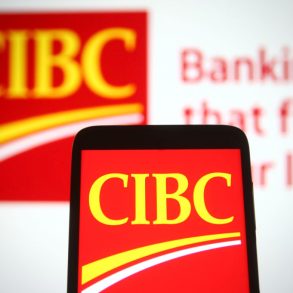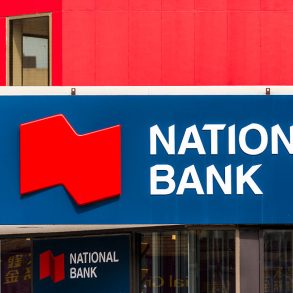 To no one’s amazement, Canada’s Big 6 Banks made money again last quarter, despite a recession triggered by the oil patch.
To no one’s amazement, Canada’s Big 6 Banks made money again last quarter, despite a recession triggered by the oil patch.
More interesting than their profitability was the focus on bank underwriting in the wake of Home Trust’s very public fraud experience. Analysts drilled and grilled bank executives on the quarterly conference calls to find out exactly what banks are doing to verify income and address application fraud. You’ll find the banks’ responses below.
Like every quarter, CMT has dug through the Big 6 Banks’ quarterly earnings reports, presentations and conference calls, and compiled the following mortgage highlights. The most notable observations appear in red.
*********
 Bank of Montreal
Bank of Montreal
Q3 net income: $1.2 billion
(+6% Y/Y)
Earnings per share: $1.86
- BMO’s total Canadian residential mortgage portfolio rose to $95.4 billion in Q3, up from $93.4 billion in the previous quarter. (Source)
- 59.5% of BMO’s portfolio is insured, down from 61.3% in the previous quarter. (Source)
- The loan-to-value on the uninsured portfolio is 58%, unchanged from Q2. (Source)
- The condo mortgage portfolio stands at $13.8 billion (up slightly from $13.4 billion in Q2) with 52.1% insured (down from 52.8% in Q2). (Source)
- Loss rates for the trailing four-quarter period were 1 bp and the 90-day delinquency rate is 26 bps. (Source)
- Asked about some of the tactics employed to ensure that information used in the bank’s underwriting process is accurate, CEO William Downe said, “…when we originate all of the mortgages, we have a pretty stringent and rigorous way of making sure that all the verifications from income and elsewhere are in order. When we look at third-party mortgages, I think that process is even more stringent and we look at all the information that they provide us and we do have a quality assurance associated with that part of the portfolio that we buy from folks…When there is an element of what I would call fraud or fraudulent representation, we look and tighten it up even further to see whether we noticed anything…and we haven’t. So we are quite comfortable with the suppliers of third-party mortgages to us and the processes that we have in place to make sure that nothing…surprises us.” (Source)
- On third-party mortgage partners: “…We do audit [them] and we always make sure they are CMHC and NHA approved partners.” (Source)
- Asked if the bank conducts calls to employers for income verification on third-party mortgages or those from mobile mortgage specialists, Downe replied, “I am sure we do, but I can’t tell you for certain because I have not asked that question very specifically in terms of how many people we call in when we call them, but the quality assurance program and the audit checks that we do, I’m sure encompass some calling, but I can’t tell you for sure right now.” (Source)
CIBC
Q3 net income: $978 million
+6.2% Y/Y
Earnings per share: $2.42
- CIBC’s residential mortgage portfolio rose to $159 billion in Q3, up from $155 billion in the previous quarter. (Source)
- 65% of the bank’s residential mortgage portfolio is insured (down from 67% in Q2), while 35% is uninsured (up from 33%) with an LTV of 60% (down from 61%). (Source)
- 84% of the bank’s insurance in the quarter was provided by CMHC, down from 87% in Q2. (Source)
- Volume growth in residential and commercial mortgages was up 6% YoY. (Source)
- “…mortgage growth of 6% was held by above market growth in CIBC brand mortgages of 15%, partially offset by the runoff of the First Line broker business.” (Source)
- Condo mortgages made up 11% of the total portfolio, representing $18 billion, unchanged from the previous quarter. (Source)
- 66% of the bank’s condo portfolio is insured (down from 69% in Q2), and has an average LTV of 62%. (Source)
- The bank has $38 billion of indirect exposure to oil provinces Alberta, Saskatchewan and Newfoundland, or $17 billion excluding insured mortgages (up from $16 billion in Q2). Alberta accounts for $30 billion, or 78%. (Source) The bank noted that “there have been no notable increases in delinquencies in our retail portfolio.” (Source)
- “We are growing the overall (business banking) book, but the commercial mortgage book as we’ve talked about in the past for the lower margin part, we’re not growing,” said David Williamson, Senior Executive Vice President, Group Head, Retail and Business Banking. (Source)
- “…we do have and we will have for some period of time 15% growth in CIBC branded mortgages and the offsetting impact of the runoff of the broker mortgage book. So net-net our mortgage growth is about at industry average, about 6%, maybe a bit better than industry average, but it’s composed of 15% growth in the higher margin CIBC branded mortgages and a runoff in the low margin broker mortgages. So that’s wind assist on margins that we’ll have for some foreseeable time and have had for a while,” Williamson added. (Source)
- Asked if the bank expects to be able to grow mortgage share once the FirstLine run-off subsides, Williamson said, “As far as the runoff, on average, I’d say another big one year left of substantive runoff. There will be five-year mortgages, even longer term mortgages, it will run off for some extended period of time but as far as higher volume, another year…So subject to what happens in the macro environment, just from our own perspective and sustainability there, there was a couple of drivers of that which should be sustainable in the near term, one is we’ve been focusing on processes and simplifying…to just being easier to deal with and speed your response times, that’s helped our sales. And the other is our investment in mobile mortgage advisers, which were changing to mobile advisers generally, so (as to) not just focus on mortgages. But that’s a channel that we’ve been growing for a period of time. Eventually that growth will ebb as we get to a level that we think is the right optimized level across the country. But for next year, we see continued growth in that channel and that channel is becoming more effective…” (Source)

National Bank of Canada
Q3 net income: $454 million
(+3% Y/Y)
Earnings per share: $1.28 a share
- The bank’s residential mortgage and HELOC portfolio rose to $53.2 billion in Q3, up from $51.4 billion in the previous quarter. (Source)
- The portfolio is 42.8% insured (vs. 42.9% in Q2), 23.2% uninsured (down from 22.6% in Q2) and 34% HELOCs (vs. 34.5% in Q2). (Source)
- The average loan-to-value on the HELOC and uninsured mortgage portfolio was unchanged at 59%. (Source)
- Quebec represented 63% of the mortgage book in Q3, down from 65% in Q2. Ontario was 22%. Alberta represented 6%, up from 5% in Q2. (Source)
- Net interest margin in Q3 was 2.18%, down from 2.19% in Q2 and 2.24% a year earlier. (Source)
Royal Bank of Canada
Q3 net income: $2.48 billion
(+4% Y/Y)
Earnings per share: $1.66
- RBC’s residential mortgage portfolio rose to $201 billion in Q3, up from $196 billion in Q2. Volume growth is up 5.5% from a year ago and up 0.8% from Q1. (Source)
- President and CEO David McKay commented on the strong growth during the bank’s conference call, saying: “Both the seasonality of the summer mortgage season and historically low interest rates spurred a higher level of market activity for new originations and refinancing. In addition, the simplicity of our employee pricing campaign coupled with employee referrals helped drive sales. This quarter we also saw clients switch out of unsecured lines of credit into mortgage products to take advantage of lower rates, which also contributed to mortgage growth.” (Source)
- McKay added: “With this growth, we’ve remained disciplined from a risk perspective. I would point out that since we originate mortgages through our proprietary channels, we are able to work directly with clients. That helps to manage debt and we are seeing evidence of conservatism as many clients are committing to accelerated repayment plans and paying down lines of credit.” (Source)
- Asked if the mortgage growth seen in Q3 is sustainable, Jennifer Tory, Group Head Personal and Commercial Banking, said: “…some of the growth is due to client switching out of unsecured lines of credit and some early renewals as clients are taking advantage of the better rates offered on mortgage products. And as far as outlook is concerned, we continue to have a strong pipeline but there is that seasonality to the business that we expect will moderate somewhat in the fall.” (Source)
- 61% of its mortgages are uninsured (up from 60% last quarter) while 39% are insured (down from 40%). (Source) The uninsured portfolio has a loan-to-value ratio of 55%. (Source)
- 16% of the bank’s portfolio is in Alberta, up from 15% in the previous quarter. (Source)
- RBC’s condo exposure is 9.8% of its mortgage portfolio (up from 9.7%). Exposure to condo developers is approximately $3.8 billion (down from $3.9 billion in Q2). (Source)
- Gross impaired loans in the bank’s retail portfolio jumped to 0.50% in the quarter, up from 0.46% in Q2 and 0.45% in Q3 2014. RBC’s investor presentation attributed this increase “largely due to a couple of oil and gas accounts in Capital Markets and a single account in the U.S. & International Wealth Management business,” as well as foreign exchange. (Source)
- “…now virtually all of our mortgages are processed through our new system, which is an automated end-to-end origination process from sales and adjudication to fulfillment,” said President and CEO David McKay. (Source)
- Asked for the bank’s take on the recent issues of active verification in the broker channel, Tory answered: “…income verification is a key component of our adjudication process and our applications taken by branch lenders and our proprietary mortgage salesforce. And for each application we verify income, we have various ways of doing that and our policies require documents to be retained. We have underwriting in our credit adjudication centre and application review process that’s undertaken in that group, particularly for our mortgage specialist salesforce, and needs credit professionals to (perform) income verification. And so we have good processes on new clients. We originate many of our mortgages from our existing client base and so we have multiple ways to verify income, including our internal RBC information and generally we find clients are prepared to provide other forms of documentation, which are actually easier for them (such as) statements or income tax forms, which are readily available. And prior to that we have ongoing fraud monitoring of our application process to help…prevent more fraud.” (Source)
- Pressed as to the types of checks the bank performs to verify the accuracy of the documents they are presented with, Tory replied, “Well there are a number of ways you can do that including calls to employers. Also as I mentioned a good percentage of our new mortgages originated from existing RBC clients and so often that payroll will be going into their account with RBC. So we feel quite comfortable with the processes that we have in place, plus knowledge that we have of the customer that we can verify that income adequately and of course you got income tax returns, which are often what a client will provide to us as evidence of their income levels.” (Source)
Scotiabank
Q3 net income: $1.85 billion
(+3% Y/Y –adjusted for the sale of its stake in CI Financial Corp last year)
Earnings per share: $1.45
- The total portfolio of residential retail mortgages rose to $189 billion from $188 billion in the previous quarter. The portfolio was comprised of $168 billion in freehold properties (unchanged from Q2) and $21 billion in condos (up from $20 billion in Q2). (Source)
- 48% of the residential mortgage portfolio was insured in the first quarter, down from 50% in Q2 and 52% in Q1. The uninsured portfolio has an average loan-to-value ratio of approximately 53%, unchanged from the previous quarter. (Source)
- The bank had $29.7 billion in mortgages in Alberta in the quarter, up from $29.5 billion. (Source)
- Net interest margin was 2.25% in the quarter. That’s up 8 bps y/y thanks in part to “Run-off of lower spread Tangerine mortgages.” (Source)
- In response to questions about Scotia’s reaction to Home Trust finding fraudulent applications, Stephen Hart, Scotia’s Chief Risk Officer, said: “…Through all three channels that we use, all of it comes through my own central adjudication group. It doesn’t matter which point of touch the client hits. It’s the same process once it comes into the risk area. We do require independent verification of income and we need two different sources for that. That can include pay stubs, employment letters, tax returns and occasionally verbal employee confirmation. We also are probably unique that we also have a prefunding independent group that reviews all the documentation for compliance and fraud prior to any funding.” (Source)
- “…In Canada, our delinquency rates are at the lowest levels in the past decade.” (Source)
TD Bank
Q3 net income: $1.27 billion
(+8% Y/Y)
Earnings per share: $1.19
- TD’s residential mortgage portfolio jumped to $180.2 billion, up from $175.5 billion in Q2. (Source)
- The bank’s HELOC portfolio rose to $60.9 billion in the quarter, up from 60.3 billion. (Source)
- 58% of the portfolio is insured, down from 60% in the previous quarter. The loan-to-value of the uninsured portfolio is 59%, down from 60% in Q2. (Source)
- Asked for the bank’s perspective on how big a problem fraud in the mortgage market represents, Mark Chauvin, Chief Risk Officer, answered: “We follow in our underwriting standard verification of income, and the down payment is very important and central to the process. So, we will do that through several means and we will do it until we are satisfied that we have it right. So it could be tax returns…(or) if they’re a customer of the bank it would be through automatic deposits to their accounts, (or it could be) verification from employers…we would even reach out and call the employer if necessary. But in addition to that we do have fraud analytics that looks to assess the reasonableness of a declared income to make sure it makes sense. And…we do have a Quality Assurance program that follows up behind. And we even do that for mortgages that we buy from other institutions like from other second-tier areas. When we buy them we do go and look at it and it’s effective in detecting those fraud situations and picking them. And so I’m quite comfortable that we’re effectively managing it. We have the proper risk navigation in place. I don’t think necessarily that it’s gone up over time though, to tell you the truth.” (Source)
- Timothy Hockey added: “I think if you look back five years ago the heightened level of scrutiny on this market, both by all of us as lenders as well as regulators, as well as tightening (by) the Ministry of Finance; my sense is, if anything, (fraud) would have gone down a little bit and there’s certainly (a) higher degree of scrutiny on that type of activity.” (Source)
- Asked how the bank can reconcile this high level of due diligence while aspiring to a high level of service, such as turning approvals around in less than 24 hours, Hockey responded: “Well those are the standards that we actually have negotiated, (which) we’ve changed in the last little while as we entered into an outsourcing relationship with First National, and they have a very dedicated senior lending team. So what we do is we basically have outsourced our adjudication and our funding of the mortgages. They are writing to our specifications. There is no auto adjudication, which to your question might impact your turnaround times, but we’ve negotiated, as part of our pricing, the ability to actually get those approvals back quickly and we’ve seen a substantial improvement in the turnaround times to the brokers, which is one of the reasons why we are up strongly in real estate secured lending.” (Source)
Note: Transcripts are provided by third parties (Seeking Alpha and Yahoo Finance). Their accuracy cannot be 100% assured.
Steve Huebl & Rob McLister, CMT








I look forward to this report every quarter. Thank you Rob and Steve for taking the time to sort through all the information!
Thanks Lior. Company reports are like panning for gold. Lots of sand and silt, but every now and then you find a nugget.
I am with Lior, great reporting Rob. Always interesting to see the eternal CIBC comments on Firstline, it seems to haunt every quarterly call, also interesting to see Scotia’s mortgage growth is less than others, is it the run-off from Tangerine or ….? Always a great read.
Completely agree with the others…love reading this report and look forward to it
Great article Rob, I would love to see an independent party take care of this or see a quarterly report. I’m amazed how mostly RBC and CIBC get away with the income/funds documentation even for high ratio mortgages.